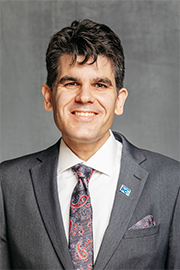- Hear!
- Rabble!
- Apr/8/24 1:30:00 p.m.
- Re: Bill 180
I know. It brings a tear to my eye, too.
That’s why our government is delivering on the most ambitious plan for hospital expansion in the province’s history, with investments of nearly $50 billion—yes, you heard correctly, $50 billion—over the next 10 years in health infrastructure, including close to $36 billion in capital grants.
Additionally, we are committing $620 million over 10 years to allow health care system partners to address urgent infrastructure renewal needs and extend the life of hospital and community infrastructure. As well, we are investing $50 million over three years to enhance and stabilize health care capacity within northern and rural communities and $45 million over three years to enhance the Northern Health Travel Grant Program.
Interjections.
We are investing approximately $94 million over three years to enhance the health and well-being of Indigenous and northern communities, with care tailored to community needs.
Interjections.
Despite a challenging global economic situation, our government continues to invest in care, education and other vital public services.
That is why we’ve continued to invest $6.4 billion since 2019 to build 58,000 new or upgraded long-term-care beds across the province by 2028. In addition, our government is investing $155 million in 2024-25 to increase funding to fast-track construction of the next tranche of long-term-care homes by November 30, 2024.
I know this will be of particular interest to certain members in this House present: We continue building, expanding and renewing schools and child care spaces by investing $23 billion over 10 years, including about $16 billion in capital grants—
While on the topic of schools, I will add that we’re getting students back to basics, with close to $172 million for the 2024-25 school year for targeted math and reading supports, as well as an updated kindergarten curriculum starting in September 2025.
We’re also supporting small, northern and rural colleges and northern universities by providing $10 million in targeted supports.
Madam Speaker, our government knows that keeping active and having access to recreational opportunities is vital to any thriving community. That’s why we are launching a new $200-million Community Sport and Recreation Infrastructure Fund—
We remain committed to creating good-paying jobs and fostering business investments that will deliver tomorrow’s economic success today.
To help attract investments and new jobs in key sectors such as advanced manufacturing, life sciences and technology, our 2024 budget allocates an additional $100 million to the Invest Ontario Fund, for a total of $600 million.
Speaking of manufacturing and technology, we’re boosting the growth of Ontario’s end-to-end supply chain for electric vehicles and batteries. I’m proud to say that over the last three years, we have attracted more than $28 billion in automotive and EV-battery-related investments from global automotive manufacturers, parts suppliers and EV battery and materials manufacturers. These are investments that are expected to create more than 12,000 new, permanent jobs in addition to spurring economic growth. This will create jobs in all of Ontario. In fact, it will create jobs in Windsor. It will create jobs—
Interjection.
It will create jobs in Kitchener-Waterloo and southwestern Ontario, in the north—right across this great province. These are the jobs of the future—jobs that will support our workers and their families for decades to come.
On a related point, as noted in our budget, in 2024, we are enabling an estimated $8 billion in cost savings and support for businesses, including $3.7 billion for small businesses. This will also help create jobs and economic growth
With this budget, we are supporting Ontario’s mining sector by investing an additional $15 million over three years in the Critical Minerals Innovation Fund. This will enhance research and development as well as the commercialization of innovators.
To add more on economic development, we are increasing the Northern Energy Advantage Program to help eligible large industrial operators manage the electricity costs and create good jobs in northern Ontario. These increases total $167 million in 2024-25 and $206 million annually in 2025-26 and 2026-27.
Madam Speaker, our government has always stood alongside our workers. Just as the Premier has said before, I’d be willing to bet on Ontario workers over those from anywhere else in the world. We continue to work for workers in this House day in and day out. That is why we are investing an additional $100 million, in 2024-25, in the Skills Development Fund Training Stream, and continue to implement the $224-million Skills Development Fund Capital Stream. We support workers, and we continue to develop Ontario’s world-class workforce, just as we are continuing to build on Ontario’s skilled trades pipeline.
We are investing an additional $16.5 million annually over the next three years through the skilled trades strategy to support a variety of programs that attract more young people into the skilled trades, some of whom are here today. This will help simplify the system and encourage employer participation in apprenticeships while continuing to provide more young people with meaningful, lifelong careers.
Madam Speaker, whether it is workers, patients, small businesses, drivers in gridlock or young families making ends meet—with this budget, our government remains on a path to build for the long term while keeping costs down. We are making investments now that will support our growing province well into the future. Our government is here to help this province overcome any challenge, invest responsibly and pave the way for our bright future.
And if you, too, believe that Ontario can continue being the best place in Canada and the world to go to school, get a job, build a life, buy a home and raise a family, then our government has a plan that will work for you.
Et si vous aussi croyez que l’Ontario peut continuer à être le meilleur endroit au Canada et au monde où étudier, avoir un emploi, bâtir sa vie, acheter un logement et élever une famille, alors, notre gouvernement a un plan qui est à l’oeuvre pour vous.
I urge all members of this Legislature to support these budget measures and join our government in building a better Ontario. This is a plan for all 16 million Ontarians and for many more who want to come to Ontario, as they look to Ontario to lead the way not just in Canada, not just in North America, but the whole world today.
- Hear!
- Rabble!
- Hear!
- Rabble!
- Hear!
- Rabble!
- Apr/8/24 1:40:00 p.m.
- Re: Bill 180
It’s with great pleasure that I rise today and speak on the second reading of Bill 180, Building a Better Ontario Act, following the minister.
Thank you to the Minister of Finance for sharing his time with myself and the member from Mississauga–Malton, the new parliamentary assistant. It has been an honour to work with the minister and his team on the 2024 budget.
Speaker, I also want to take this opportunity to thank the previous parliamentary assistant, the member from Bruce–Grey–Owen Sound, for all his valuable support in working on the budget.
Let me begin by saying I’m very confident in the Ontario government’s vision for our economy. We are investing in vital public services and in infrastructure to get more homes built faster, to attract high-quality, high-paying jobs, and to keep costs down for families and businesses, all while retaining a path to balance and all during a period when Ontario, like the rest of the world, continues to face economic challenges and uncertainty.
I’d like to take a few minutes to expand on some of the economic proof points of the times we find ourselves in, as shown in the 2024 budget. As detailed there, high interest rates are expected to continue negatively impacting Ontario’s economy in 2024.
The outlook for real GDP growth in 2024 has deteriorated significantly over the last year. The budget also shows that following estimated real GDP growth of 1.2% in 2023, growth is projected to be at 0.3% for 2024; this is down from 1.3% at the time of the 2023 budget and 0.5% at the time of the 2023 economic outlook and fiscal review. Real GDP growth is projected to then increase to 1.9% in 2025 and further rise 2.2% in 2026 and 2027. This also represents slower projected growth compared to the 2023 budget and the 2023 economic outlook and fiscal review. Bear in mind, for the purposes of prudent fiscal planning, the Ministry of Finance projections are slightly below the average of private sector forecasts.
Meanwhile, employment in the province is projected to rise by 0.8% in 2024, slowing from a 2.4% increase in 2023. A positive is that the unemployment rate over the outlook period is projected to remain below the recent historical average.
Geopolitical developments are key economic factors and continue to pose a significant risk to Ontario’s economic outlook. For example, commodity markets and supply chains continue to be impacted by these global events.
A final key piece to this macroeconomic picture is that rising tensions are continuing to weigh on international trade and goods and services, which could impact Ontario’s key trading relationships around the world and here in North America. These geopolitical risks and possibilities are outside the power of provincial governments to influence, even if they may have ramifications on the provincial government.
For 2023-24, the government is projecting a deficit of approximately $3 billion. As part of our path to balance, the government is projecting deficits of $9.8 billion in 2024-25 and $4.6 billion in 2025-26, before reaching a surplus of $0.5 billion in 2026-27. So we do have a path to balance.
Speaker, to paraphrase the minister, we are not letting these things divert from our plan to build Ontario. Many of our 2024 budget initiatives are focused on health care. A marquee piece the minister revealed is how we are establishing the first medical school in Canada that is primarily focused on training family doctors right here in the GTA, at York University.
Just as we need more family doctors, we also need more nurses, which is why we are investing $128 million over three years to support sustained enrolment increases of nursing spaces at publicly assisted colleges and universities by 2,000 registered nurse seats and 1,000 registered practical nurse seats.
We are helping more people access convenient health care by investing an additional $965 million in hospital operating funding in 2024-25. This is a 4% increase in total base hospital operations for an unprecedented second year in a row.
We are connecting approximately 600,000 more people to primary health care through new and expanded interprofessional primary care teams with a total additional investment of $546 million over three years, starting in 2024-25.
We are investing an additional $2 billion in the home and community sector to support expansion and increase compensation for front-line workers, because strengthening and growing the health care workforce is critical to both our health care and our economy. That is why we are investing $743 million over three years to help address immediate health care staffing needs and prepare for the future.
We are also adding more health care workers in underserviced communities, with more than $30 million in funding injected to date through the expanded Ontario Learn and Stay Grant program. The grant provides full, upfront funding for tuition, books and other educational costs. The grant is for students who enrol in an eligible nursing, paramedic or medical laboratory technologist program, in return for working in these communities where they studied for a term of service after graduation. The Ontario Learn and Stay Grant program demonstrates how committed we are to building a stronger, more resilient health care workforce in underserved communities in northern, eastern and southwestern Ontario.
Speaker, I want to share how we are building on the historic investment of $3.8 billion over 10 years—this investment is for mental health and addictions services, as part of the Roadmap to Wellness: A Plan to Build Ontario’s Mental Health and Addictions System strategy, by investing $396 million over three years. These funds will go to stabilizing, improving access and expanding existing mental health and addictions services and programs.
We know we need to support individuals facing unstable housing conditions and dealing with mental health and addictions challenges. This is the reason why we are investing an additional $152 million over the next three years towards various supportive housing initiatives designed to support vulnerable people.
Speaker, rising costs have, no doubt, impacted household budgets, and there are no two ways about that.
The government continues to help Ontario’s most vulnerable, including individuals living with mental health and addictions challenges who are experiencing unstable housing conditions, and low-income seniors.
We are ensuring that more seniors who need to get the help they need get it by expanding the Ontario Guaranteed Annual Income System, commonly known as GAINS, and indexing the GAINS benefit to inflation. This change is monumental and will provide financial support to approximately 100,000 additional low-income seniors.
This isn’t the only way we are helping people who may be seeing great strains on their family budgets. For example, we are making electricity more affordable for thousands of additional, low-income families. We are increasing income eligibility thresholds for the Ontario Electricity Support Program up to 35% as of March 1, 2024.
We are helping to provide savings, daily, for riders on participating public transit systems through the One Fare program—savings that average $1,600 per year. The program works by allowing transit riders to only pay once to transfer between GO Transit, the TTC and other participating transit systems in the GTA.
Speaking of GO Transit, we are continuing to work to expand or improve GO Transit, in improving stations and other installations on the Kitchener GO line to enable two-way, all-day service. We are increasing train service between Union Station and the Niagara region, with more express service between Hamilton, Burlington and Toronto.
Our government is also helping drivers; make no mistake, Speaker. In addition to the proposed extending of the existing gasoline and fuel tax rate cuts until December 31, 2024, we are keeping costs down for drivers by proposing to ban any new tolls on new and existing provincial highways and freezing fees on drivers’ licences and Ontario photo cards. These initiatives, when their savings are totalled, will save drivers an estimated $66 million over the next five years.
I can add that in alignment with previous budget commitments, the government is moving forward with auto insurance reforms that would empower Ontario drivers with more affordable options, improved access to benefits, and create a more modern system. As noted in the 2024 budget, implementation of the proposed changes will be done in a way to help ensure that drivers are able to make informed decisions when choosing insurance coverage options that are available to them.
While we are speaking to the needs of Ontario car owners, let me add that we are fighting auto theft with a plan that includes $49 million over three years to help police put auto thieves behind bars. As well, over three years, we are investing $46 million to improve community safety in the greater Toronto area by supporting increased patrols and faster response times to major incidents and serious crimes. This is for the purchase of four police helicopters.
Community safety is absolutely essential. Having and using a reliable car and good mass transit systems are also essential in today’s age.
Having a place to live is, of course, a priority in everybody’s life. A priority of this government is fighting market speculation that may be contributing to people having challenges in finding a place to call home. That is why we are deterring foreign investors from speculating on the province’s housing market by strengthening Ontario’s non-resident speculation tax, the most comprehensive tax of its kind in Canada, with amendments to support compliance and improve fairness.
Education is also, of course, a priority of this government. That is why we are getting students back to basics with close to $172 million for the 2024-25 school year for targeted math and reading supports. As well, an updated kindergarten curriculum is starting in September 2025.
I would be remiss if I didn’t also spotlight a few initiatives related to children and families. For example, the government is increasing the investment in the Ontario Autism Program by $120 million in 2024-25, which will double the increase provided in 2023-24.
We are also providing an additional $13.5 million over three years, on top of existing investments of $1.4 billion over four years, to enhance initiatives that support women, children, youth and others who are at increased risk of violence or exploitation, including an additional $4.5 million over three years for the Victim Quick Response Program+, to increase access to necessities for victims of human trafficking and gender-based violence and their families, especially those in rural and northern communities.
To help young people access mental health services close to home, our government is investing $8.3 million over three years to add five new youth wellness hubs, bringing the total to 32.
Since 2020, the province has established 22 youth wellness hubs which have helped connect over 43,000 youth and their families to mental health and wellness services, accounting for over 168,000 visits. Five more hubs are in the planning stages, set for Port Hope, Thunder Bay, Oxford county, Vaughan, and Brampton. A west Toronto location opened just last January.
Speaker, the Building a Better Ontario Act (Budget Measures), 2024, contains many initiatives that move our plan forward. Of course, it contains the gas and fuel tax I discussed a few moments ago. They include measures relating to the Building Ontario Fund, the taxation of computer animation and special effects productions in the entertainment industry, the taxation of wine, and other measures that impact the pension plan landscape. The measures also propose minor legislative amendments to clarify or improve administrative effectiveness or enforcement or to maintain the integrity and effectiveness of various statutes administered by the Ontario Minister of Finance.
As I conclude my remarks today, let me just say that our government is proud of all it has accomplished, yet we know there remains much more work to be done. In the face of high interest rates and global economic uncertainty, our government is working very hard to keep costs down, to rebuild Ontario so that families, businesses and municipalities that all call Ontario home can prosper. We are on track to make sure Ontario is once again the economic engine of Canada. Most importantly, we will do this while we continue to be prudent and have a responsible approach and retain a path to a balanced budget.
I encourage all members to vote in favour of this bill, Building a Better Ontario Act (Budget Measures), 2024.
I’d now like to pass my time over to my colleague the member from Mississauga–Malton and the parliamentary assistant to the Minister of Finance.
- Hear!
- Rabble!
- Apr/8/24 1:50:00 p.m.
- Re: Bill 180
It is always a pleasure to rise in the House to talk about the important things the government is doing.
Speaker, the only thing certain in the life of an MPP is the uncertainty. Last week, when I had the opportunity to talk about the budget, I wasn’t even sure that I was going to be doing the same thing today. Thanks to the Premier and thanks to the confidence of the minister, I am now in the Ministry of Finance. So all I would say is that uncertainty is the only certain thing that we have.
As I rise to speak on second reading, I want to acknowledge the hard work of the Minister of Finance, what he has done along with his two wonderful PAs, the MPP from Oakville and the MPP from Bruce–Grey–Owen Sound. I was with them on the committee as well, and I’ve seen the hard work they have put into this budget bill. So I want to acknowledge and thank both of them for their hard work.
I see my former Mississauga–Malton resident and now a councillor in Bruce–Grey–Owen Sound; Monica is here, as well. It’s good to see you here, Monica, as we talk about the 2024 budget.
The measures that are contained in this bill to deliver strength to the province of Ontario—we call it our plan to build.
Speaker, I would like to spend a few minutes to put the spotlight on notable initiatives contained in this budget, Building a Better Ontario Act (Budget Measures), 2024. These are important measures that each, in their own way, support and help move forward our work as a government.
We all know affordability is an issue. We all know about the federal carbon tax and the pressure it is putting on the people of Ontario. Thankfully, we have a government that believes in the people of Ontario. We’re standing shoulder to shoulder with the people of Ontario to support them in these crises.
One of the most impactful decisions that our government has made which affects the day-to-day life of all Ontarians is the decision to reduce the gas price. We’re introducing proposed legislation that, if passed, would extend existing the gasoline and fuel tax reduction until December 31, 2024. With this extension, we are continuing to keep costs down for families and businesses. As the members of this House are aware, the Ontario government temporarily reduced the gasoline tax by 5.7 cents per litre and the fuel tax by 5.3 cents per litre, for diesel, from July 1, 2022, and it was supposed to be finishing up on June 30, 2024. Thanks to this budget, with this newly announced extension, we will make sure that the rates remain at nine cents per litre until December 31, 2024, saving Ontario households $320, on average, over the two and a half years since the tax rate cuts were first introduced.
As the minister said when this proposed extension was unveiled in Mississauga–Lakeshore, our government understands that high inflation and interest rates are hurting Ontario workers and their hard-earned paycheques, and we will be standing shoulder to shoulder with them, continuing to support Ontario families by reducing the cost of gas.
Another thing which I get amazed with is film production. I’m sure many of our colleagues know that we, as Hollywood North, produce close to $3 billion in film production. And that film production is not just content, but it’s an economic powerhouse; it brings in the revolutions. It gives residents the ability to showcase their talent. Under the leadership of Premier Ford, we support film production, and we’re not just saying it, but we’re doing things. For example, we are making sure the Ontario Computer Animation and Special Effects Tax Credit is simplified. The Ontario Computer Animation and Special Effects Tax Credit, or OCASE for short, is an 18% refundable tax credit available to companies that undertake computer animation and special effects activities on eligible film and television productions in Ontario.
Speaker, if you remember, when we were growing up, Bambi was the first animation movie that we watched—and I do know how much it affects and how much pleasure it gives to our youth and now, in fact, even adults. So this is what we’re doing here again.
To be eligible for this tax credit, a film or television production must also be certified for either the Ontario Film and Television Tax Credit or the Ontario Production Services Tax Credit—something we call “tethering” to these other film and television tax credits. The budget measures bill proposes to remove this tethering requirement and seeks to replace it with new eligibility rules to ensure the credit continues to only support professional productions. In other words, we are making sure that we are delivering on the government’s commitment to explore opportunities to reduce red tape, simplify tax credit support for computer animation and special effects activities, so that we can see a lot more production, a lot more economic activities.
This budget is full of wonderful things to support the province and the people of the province; for example, supporting our workers.
Madam Speaker, I remember when my father retired, after all his hard work for over 35 years working in a government job. It gave him pleasure to do things which he wanted to do now that he had some time. On one side, he had time, but on the other side, he was worried about the cost of living, his expenses and the compensation. And he’s not alone. After working hard, we want to make sure that we can continue to have a lifestyle that we have built over years.
This is the way our government is making sure we help those workers who helped us to build a greater, stronger Ontario.
We’re making progress concerning Ontario’s pension plan landscape. We’re working to implement a permanent target-benefit framework. If you’re a worker, if you’re in the industry, please join our hands—help us to build this.
Following consultations over the past year, legislative amendments to the Pension Benefits Act are being proposed through the 2024 budget bill. These amendments would implement policy changes arising from the 2023 stakeholder consultations, as well as legislative housekeeping matters. We are currently preparing the regulations that would be necessary to implement the target-benefit framework which the government intends to come into effect on January 1, 2025.
Target-benefit pension plans will provide a monthly stream of income in retirement, with predictable contributions for employers. Implementation of a permanent target-benefit framework would pave the way for more employers to offer workplace pension plans, increasing the opportunities for workers to save for their retirement. This is yet another way we’re working for our Ontario workers.
In 2023, as we know, employment in Ontario increased by 2.5%—increases in both full-time and part-time. Under the previous Liberal-NDP government, we saw 300,000 jobs going out of manufacturing. Since 2018, there are 700,000 more people working in the province of Ontario—helping, contributing and building Ontario.
Interjections.
- Hear!
- Rabble!
- Hear!
- Rabble!
- Apr/8/24 2:00:00 p.m.
- Re: Bill 180
Thank you to the member for Essex for that encouragement to the government for building a better, stronger Ontario—speaking of which, to the member for Essex, I want to talk about the Building Ontario Fund. We look at the revenue of Ontario going from $150 billion to $200-billion-plus. It’s no coincidence; it is the policy put in place by this government—making sure and helping business to invest in Ontario.
I’ll give you an example. I was talking to a pension fund—and he explained to me that they’re investing $60 billion for infrastructure projects in India. I happened to ask them, “Why don’t you do it here, close to home, close to the heart, where we can invest that money into the infrastructure here, build a stronger Ontario, stronger Canada, and bring more investments into Canada?” When we do this, the revenue is going to increase. When we increase the revenue, it gives us more opportunity to serve Ontarians, flow back into more services.
Thankfully, we have a solution now. The budget measures would establish Ontario’s new infrastructure bank—the Building Ontario Fund—in a new, stand-alone statute. This fund is another step in our government’s plan to build and attract top-quality investment to Ontario and fund infrastructure that would otherwise probably not get built.
The Ontario Infrastructure Bank was announced in the 2023 Ontario Economic Outlook and Fiscal Review as an important tool to attract capital to help build essential infrastructure. The Building Ontario Fund continues to make progress in laying the foundation of future successes as it establishes a governance framework and builds out the organization, including recruitment of the chief executive officer. The fund is also exploring opportunities to support large-scale projects in the post-secondary student housing, long-term care, energy generation and municipal infrastructure sectors.
This gives an opportunity to all our colleagues. I call each one of us the champion of our riding. We’ve been elected by the people to represent their voice, but at the same time to help them build a better riding as well.
So I encourage all the members of this House to go back to your riding, talk to your stakeholders, identify those projects. Bring those projects, whether it is, for example, in Brampton South, building up another housing for Sheridan College, or maybe building up another residence in Kingston or maybe a long-term-care—as we’re talking about all this progress.
We’re talking about EV batteries—maybe building another EV plant. I was talking to another stakeholder in my region of Peel: Sony Electronics. They’re building up EV chargers.
To build all this infrastructure, we need money—the municipal infrastructure sector. For example, my councillor, Brad Butt, always talks about building a bridge that can connect Etobicoke with Mississauga. It will save a lot of time. It’s not just saving time—it will make sure that the people of Ontario who are driving on that bridge have more time with their family and have better productivity. By doing so, we can encourage more investments coming into Ontario, building our revenue base as well.
So what is this doing? The fund is currently engaging with Canadian entities with long-term investment horizons and an Ontario-based post-secondary institution to help finance new student housing projects. This fund is also exploring opportunities with partners to finance major energy generation projects, including attracting investment to build new nuclear projects.
For example, we can build green hydrogen. We have trucks, and the trucks need DEF, diesel exhaust fluid. To make that diesel fluid, we need urea, and to make that urea, right now we’re using ammonia. Instead of using ammonia, we can use hydrogen, which is made by electrolysis through electricity. To do that, we need infrastructure. And that’s exactly what this fund is going to do.
First announced in the 2023 Ontario Economic Outlook and Fiscal Review, the fund is an important tool to attract capital to help build essential infrastructure.
Madam Speaker, as the government moves forward with Ontario’s plan to build, the fund will act as a tool to attract capital, to help meet the infrastructure needs of a growing Ontario and ensure that we are building the critical infrastructure necessary to support all Ontarians.
We all know that at the end of every paycheque, a small amount of money is deducted as a pension. All these pension funds collect that money and invest in projects so that they can increase the size of that pension and help the recipients of their pension fund at the time of their retirement. Rather than investing this pension fund across the globe, what if we created opportunities right here at home? We’d have double benefit. We could invest that money into the infrastructure. Our Ontarians would get the benefit. We’d get them more investment, and those pension funds would be able to increase their benefits to the pension fund holders by investing those funds. So it’s a win-win situation. I hope all the members in this House will go back to their ridings, look at those projects and support us in these kinds of pension fund investments.
Madam Speaker, our goal very simple—simple but powerful. The government is working hard to build a better Ontario. That is what we’re doing through this budget, with many examples of new and expanded initiatives to meet these objectives. And we’re doing it all across province. We truly believe that when we make investments across each sector, each geographical location, and when we support Ontario, we build a better, stronger Ontario.
How are we doing it? I’ll give you some examples. Let’s start with $94 million over three years to enhance the health and well-being of Indigenous and northern communities, with culturally responsive and safe care tailored to community needs—investing $1.1 million in funding to Maamwesying North Shore Community Health Services, to support the Soo and surrounding First Nation communities; helping Indigenous workers in northern Ontario train for rewarding careers, with $7.3 million through the Skills Development Fund.
These are not just numbers. These are the actions on the ground. We’ve seen, for far too long, the north was left behind by the previous government. That is why we’re providing the investment needed to ensure it has the support it needs today.
Let’s look at the southern region.
On the communications front, we are investing more than $63 million in the Southwestern Integrated Fibre Technology project to bring high-speed Internet access to over 64,000 more homes, businesses and farms across southwestern Ontario.
As the member from Chatham-Kent is smiling and saying—it’s not just the Internet; when you bring the fast Internet, you bring the investment. When you see these investments made, the businesses come.
Our longest-serving member on this side, from Oxford, is nodding and saying, “Yes, these are the important investments we need to make now,” so that we can utilize that fund which we just talked about, so that we can have these pension funds coming and making those investments, so that we can increase the revenue for Ontario, so that we can spend that money in doing more for the people of Ontario. So it’s like a circular economy. We’re making sure that we work hard, we make more money, we invest that money, we give more service. As people are happy, we bring more investment. When we bring more investment, we increase the revenue. Let’s continue that cycle.
I’m very passionate about Mississauga–Malton, so I can’t resist talking about the Hazel McCallion LRT line. A downtown loop would connect the city of Mississauga’s Square One district, and the Main Street extension would bring the LRT into downtown Brampton.
Madam Speaker, I still remember the time when the Hazel McCallion line was named after Hazel McCallion. She was standing right next to me, and she said, “It sounds so weird. It looks so weird. The majority of these names were done when the person is gone. I’m actually naming my own line, in front of me”—but that goes to the hard work she had done; that goes to the supreme power that had been blessed to her.
To Hazel: I still remember that time, and I want to say thank you for all your hard work. And “Do Your Homework”—that mantra that you gave is the one which is helping us, as well.
I don’t have much time left, and there’s a lot more to cover, so I’m going to talk a little bit of eastern Ontario, as well—I don’t want to say only about northern and then southern; when I meet the members from eastern Ontario at the time of AMO, they’re going to say, “Oh, you guys didn’t talk about us.”
In eastern Ontario, we’re planning new campsites in provincial parks. We are electrifying provincial park campsites, including at Sandbanks.
We are continuing our government’s plan to build long-term-care homes across Ontario. We are opening new long-term-care homes in the region, including Woodland Villa, for example, in Long Sault. It opened in December 2023, with 17 new long-term-care beds and 111 upgraded long-term-care beds.
We’re improving services and supports for people in eastern Ontario—such as, in Ottawa, maintaining supportive housing for Salus that includes relocating 79 displaced low-income tenants with mental health and/or addiction needs.
We’re investing more in primary health care teams, including, in Kingston, more than $4 million in funding that will help up to 10,000 people connect to team-based primary health care.
In Peterborough, for example, more than $3 million in funding will allow the newly established Peterborough Community Health Centre to connect up to 11,375 people to team-based primary care.
On the highway infrastructure front and the economic main cable that is Highway 401, we are replacing Highway 401’s Hallecks Road bridge in Leeds and Grenville and widening the 401 easterly from Brock Road in Pickering, and replacing bridges in Port Hope.
These are some of the examples.
I highly encourage the people of Ontario to take a look at the budget book. It’s pretty detailed. It gives you a lot of investments that our government is making, with your help, so that we can build a better, stronger Ontario. As the members of the government, we have been talking about it; we’re not the only ones, though. We go out and we ask people how we’re doing.
I’ll start with a quote from the mayor of Burlington. She said, “We are thankful that the province is listening to municipalities and working with our mayors to address the issues we are facing in our communities....”
The CEO of the Ontario Medical Association said, “Ontario’s doctors welcome the health care investment in this budget. The OMA identified three urgent priorities in our Prescription for Ontario: Doctors’ Solutions for Immediate Action and asked the government for action.... We look forward to working together with the government and our partners on continuing to build a system for today and the future.”
The president and CEO of TRBOT, the Toronto Region Board of Trade, said this: “Following 20 years of massive population growth in the Toronto region, this ‘building budget’ is what the doctor ordered. We applaud the government’s significant investment in critical transportation....”
These are quotes from people across our province.
To conclude, I would like to pick up the torch of a theme the minister said. Yes, like the rest of the world, Ontario continues to face economic uncertainty and pressure due to high interest rates and global instability. These pressures are being felt day to day by Ontario families, businesses and municipalities. Yet, in the face of these pressures, our government is going to continue to work hard and to build a stronger Ontario, the course this bill helps move forward.
That is why I’m very confident that not only the members of the government, but each and every member of this House will support building a stronger, better Ontario by supporting the Building a Better Ontario Act, 2024.
- Hear!
- Rabble!
- Apr/8/24 2:20:00 p.m.
- Re: Bill 180
Thank you to the member opposite for the question.
Planning grants for hospitals are critically important.
We are building hospitals across the province of Ontario. When we took power, when we were elected in 2018, the health care system in Ontario was in dismal shape. We had a shortage of nurses, doctors; closing of hospitals. Our focus is getting that rebuilt. And we lived through COVID, I might add, in between all that. But our focus is still resolute. We are here; we have shovels in the ground in the Niagara Health System, Scarborough Health Network, Ottawa Hospital, Cambridge Memorial and more. We will continue to stay focused on building health teams and the infrastructure that they need to be able to operate efficiently.
Infrastructure is critically important wherever you are in the province. Whether you’re in downtown Toronto, in downtown Ottawa, in Collingwood, in Oakville, in Burlington, it’s critically important.
Our government is committed to working with the municipalities to make sure they have the proper investments. In this budget, we’ve put through a billion dollars in the Municipal Housing Infrastructure Program.
We’re also quadrupling the Housing-Enabling Water Systems Fund, which I think will help a lot of municipalities that are in dire need of effective, cost-effective safe water and systems in their municipalities.
We’ll continue to work with all municipalities across the province to ensure they have the infrastructure they need for the growing population.
In terms of my community, specifically, in Oakville—I could talk for hours on this, but I’ll focus on one or two issues of how this budget is helping people.
This budget is helping commuters. My town is a major community that has commuters going to downtown Toronto on a daily or regular basis. Many of them take Oakville Transit and then transfer to the GO station. Well, now, one tap, one pay—$1,600 a year. That is an incredible savings. And that’s after-tax dollars that people are saving. That is enormously going to help them.
Also, the gas tax cut that we’re putting through and proposing to extend to December 31 is going to save all those commuters who are driving in Oakville.
This budget is focused on helping affordability throughout the province of Ontario.
- Hear!
- Rabble!
- Apr/8/24 2:20:00 p.m.
- Re: Bill 180
It’s always an honour to rise in this chamber and bring the voices of the residents of St. Catharines.
Speaker, at a time when rich, well-connected people in Ontario are benefiting from this government and working families like Nina and her husband struggle, how can this government defend a budget that fails to address the soaring cost of living; a budget that is failing their duty to build affordable housing, which even our federal counterparts are pointing out that Ontario, with this Conservative government somewhat at the helm—and a helm which seems to be a sinking ship, may I add—a government that is desperately failing the duty to build affordable housing, which is affecting real people in communities across St. Catharines and Niagara?
- Hear!
- Rabble!
- Apr/8/24 2:20:00 p.m.
- Re: Bill 180
I want to start by saying thank you to the member opposite for talking about affordability, something this government takes very, very seriously.
This is a government—all the members strongly stood up in this House and talked again and again about scrapping the carbon tax. We talked about reducing the cost of gas. The member from Oak Ridges talked about the One Fare program that will help and make sure that commuters can save $1,600.
We are continuing with our previous decision to expand the LIFT, the low-income workers tax credit, to provide more relief to low-income Ontario workers, and of course, reducing the gas reduction, which I spoke about—$320 in savings.
Madam Speaker, I truly believe this is a government that believes and understands that affordability is an issue. We are here to support our residents of Ontario, and we’ll make sure we’ll continue to build those measures to help Ontarians.
- Hear!
- Rabble!
- Apr/8/24 2:20:00 p.m.
- Re: Bill 180
Speaker, this budget—and you’ve been listening carefully, I know, this afternoon—reflects the government’s commitment to housing, health care, infrastructure and economic development. I’d like the member from Oakville to talk about the effects of the budget in those particular areas, please.
- Hear!
- Rabble!
- Hear!
- Rabble!
- Apr/8/24 2:20:00 p.m.
- Re: Bill 180
As we are debating the budget, we should be debating the priorities of the government for the province. I would have hoped to have seen tangible health care investment for folks in my neck of the woods.
Specifically, something missing from this budget was what would be about $3 million—the cost of a planning grant to allow Lakeridge Health to begin the advanced planning and design work on a much-needed hospital in the Durham region. An expert panel selected Whitby. The Premier said we’d be getting a planning grant soon.
So my question to the Minister of Finance, who happens to be the MPP for Pickering–Uxbridge: When will the minister let Lakeridge Health get that planning grant, get started with that grant to begin the design work and start the wheels turning for health care in the Durham region?
- Hear!
- Rabble!
- Apr/8/24 2:20:00 p.m.
- Re: Bill 180
My question is for the parliamentary assistant. One of the things I always look for in the budget is the four-laning of Highway 69 to Sudbury. It took till page 56 to find this phrase—here’s one sentence: “Continue to widen Highway 69 from two to four lanes, from Parry Sound to Sudbury.”
Interjection.
So are you doubling, tripling, quadrupling the amount of work you’ve done in the past? Zero times anything is zero. When are you going to get this done?
- Hear!
- Rabble!
- Apr/8/24 2:20:00 p.m.
- Re: Bill 180
My question is for the member from Oakville.
A big priority for this government is making sure that we get much-needed housing built across the province and the different types that we need. One of the impediments for that is infrastructure shortages.
I know in my riding of Simcoe–Grey there are a number of municipalities that have water and waste water issues that they’ve got to clear up so that they can grow in a planned and intentional way. I’m wondering if the member could tell us how this budget is going to help accommodate that.
- Hear!
- Rabble!
- Hear!
- Rabble!
- Apr/8/24 2:30:00 p.m.
- Re: Bill 180
I want to thank both parliamentary assistants and the minister for their remarks today.
I know one thing that we’re used to in Windsor-Essex is announcements followed by no follow-through—Highway 3 was one, named Bruce Crozier’s Way in honour of the late MPP for Essex, but then 10 years of inaction.
One of the great announcements that was part of this budget was the E.C. Row Expressway/Banwell Road interchange—$50 million. This is transformative for my community—both my municipalities.
I want to find out from the parliamentary assistant what the benefits are of investments in infrastructure, in terms of employment, in terms of commute times, getting people home to their families and helping the people of Ontario.
- Hear!
- Rabble!
- Apr/8/24 2:30:00 p.m.
- Re: Bill 180
Thank you to the member from Windsor–Tecumseh.
You raise a good point about what kind of return you get on infrastructure. The previous Liberal government spent a lot of money, as we all know; I don’t think we saw much for that. We didn’t see efficient transit. We didn’t see schools being built; in fact, they were being closed—over 600, I believe, in the province at that time. Hospitals were in dire shape.
Investing in infrastructure is a long-term payoff. It helps people on a personal level when you have the hospitals and the facilities to be able to support them through their difficult times. It’s also an investment.
As you’ve mentioned, the roads that we are building and widening in the Windsor–Tecumseh area—that’s a critical border point, and having trucks be able to move more efficiently across the border will get goods to their market quicker, more efficiently and safely. It will also help families who are commuting and driving their kids to soccer practice or going back and forth to school or work. It’s going to let them get there safely. So it has a dual effect of being positive from a financial point of view but also on a personal and a family issue, as well.
- Hear!
- Rabble!
- Apr/8/24 2:30:00 p.m.
- Re: Bill 180
I think it’s so symbolic that I get to start my one-hour lead on this particular budget for 2024 just as a solar eclipse will be hitting southwestern Ontario.
Interjection: Dark times.
Bill 180 obviously will have an impact on the people of this province.
I’m listening to the government members as they talk about the highways and the infrastructure; they leave out people a lot.
You can talk about opening a bed, but you certainly can’t open that bed without a nurse or without a health care worker.
So complicated is this relationship now between the people who serve the public and the Ford government that they’re actually moving further and further apart.
If you really want to build a strong province that’s inclusive, that’s reaching its potential, that’s meeting its climate change targets and that’s actually building on the spirit of the people of this province, you have to talk about people. And those people are still feeling the impacts of your unconstitutional piece of legislation, Bill 124. In fact, I would say that this province is going to be feeling the negative impacts of that wage theft—really, wage theft, and also wage control—in Bill 124.
It has been quite a day. I just want to start off by saying it was really powerful this morning—I was really pleased to welcome the Roth family to Queen’s Park. It has been emotional, because we all care so deeply about mental health. It’s one thing to care about an issue, but that caring and that compassion need to also translate into direct investments, into resources. As I’ve said many times in this House, when people have the courage to come forward and to ask for help, the system has to be there for them. We’ve done a lot of work on the stigma around mental health and mental illness, and so now people do feel like they can actually talk about their feelings, whether they’re farmers or construction workers or young people like Kaitlyn Roth. And those resources need to be there.
I want to thank the minister responsible for mental health. He did meet with the family after today’s question period. This is the third time we’ve met with that minister. I will tell you, as the Waterloo rep, the MPP, and also the finance and Treasury Board critic, I want that minister to have access to the funding that the government is promising, I want that funding to flow, and I want it to be a smart investment.
That’s why we’re so committed to the alternative destination for those who are suffering from mental health issues and a crisis. The emergency room is not the best place. From a basic, common sense perspective, I would hope that we could all agree that if you are in crisis, going to the emergency room and waiting 18 hours, with police there, with people in pain, with people in crisis—it’s not the best place. Let’s work together on this and redirect people to these alternative destination clinics, where people are trained, where they’re going to be met with compassion, where there’s going to be some empathy, where there are going to be some special strategies so that people feel supported—like Kaitlyn. When people fall through those cracks, we lose our potential as a province. I think that’s probably one of the most painful things about suicide. Kaitlyn was so talented and so smart. She wanted to work with special-needs children. Lord knows, we have a wait-list of 60,000 people who are on the autism spectrum who need that resource and need that compassion.
So I want to thank the members who were supportive this morning, and I want to thank the Roth family.
I also want to say a special happy birthday to my daughter. She’s 23 today. She’s navigating the world of retail. She’s a business leader with an American company here in Canada. And let me tell you, it’s not the best place to land as a young worker, but she’s learning some good lessons, and I’m very proud of her.
As I mentioned, the eclipse is set to happen very soon. I hope that everybody is being safe with regard to that. I want to thank the Perimeter Institute in Waterloo for sending me some guidelines and sending me some fancy glasses that you literally cannot see anything out of, which I think is the idea. We’re lucky to have the Perimeter Institute in Waterloo region as an anchor company that is doing some amazing work.
I do want to say, as we talk about this budget—and some members have heard me talk about this. Budgets really are moral documents. They really, truly tell the story of the priorities of the government of the day. They tell the story of where the money is going and/or where the money is not going. There are a lot of places, with this particular government, where the money is not going, where it needs to be going, which would actually save the province money down the line, and I’ll get to that in a second.
The need for government transparency is akin to the darkness before a solar eclipse, so you’re going to see how I’m going to tie this all together. What we have here in Ontario is a solar eclipse of common sense. And when I say common sense, there are good places to—
Interjection.
If I start singing Bonnie Tyler, we’re all in trouble here—which will not happen. A total eclipse of the sun. The hair in those days was really special.
The need for government transparency is akin to the darkness before a solar eclipse, highlighting the importance of shedding light on the government’s actions, for public scrutiny.
Boy, I’ve never seen a government that is so resistant to sharing what’s actually happening in Ontario—aside from the commercials that we’re all paying for that tell us this fairy tale where people can afford housing, where people can find jobs, where people can find a doctor, or ensure that you can go and get the appropriate mental health resources that you need.
This decline in transparency, particularly with this government, based on what I’m hearing from people in the Kitchener-Waterloo area, is a loss of trust. That loss of trust really started right from 2018, when the government who said, “We’re never going to interfere with municipal governments,” cut city council in half—during an election, at midnight, no less.
This was a government that said, “We’re tough on law and order,” and yet, we have a justice system that is failing to meet the needs of both victims and the accused, I would say, where a record number of court cases have been stayed. I’m particularly concerned about those sexual assault cases.
Last week, our critic to the Attorney General hosted a press conference here and had two victims of sexual assault come to this place and talk about how they were denied justice in Ontario.
When you deny justice, it’s really hard to be talking about being tough on crime, as this government likes to espouse.
And so, just as the solar eclipse reveals the hidden layers of the sun, this budget reveals that the government is failing to meet the needs of the most vulnerable in Ontario. I believe that to be true. I believe that when I tell people in Waterloo and demonstrate how this government is failing so—I would say they’re overachieving on the failing perspective. The people in Waterloo hear it. They see it. They feel it. They’re experiencing it. And I’m going to talk about some of those people.
Just as a little joke—how does the man in the moon cut his hair? Some people say, “How?” Eclipse it; they eclipse it—
Interjections.
- Hear!
- Rabble!














